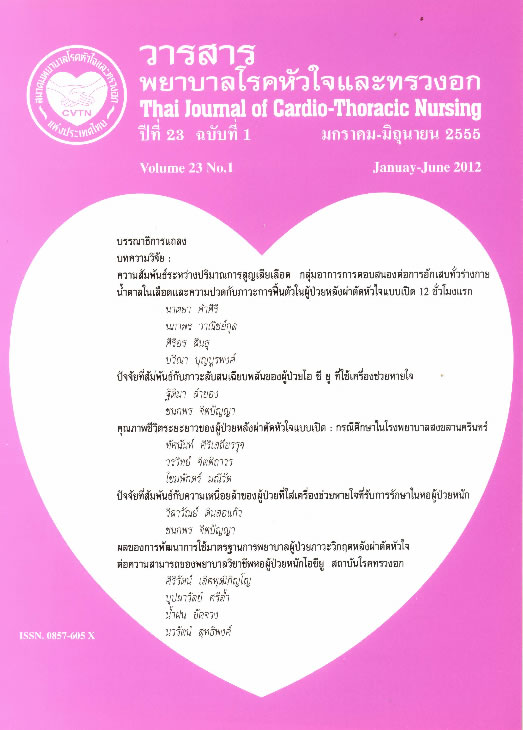ปัจจัยที่สัมพันธ์กับภาวะสับสนเฉียบพลันของผู้ป่วย ไอ ซี ยู ที่ใช้เครื่องช่วงหายใจ
Keywords:
ภาวะสับสนเฉียบพลัน, เครื่องช่วยหายใจ, ปัจจัย, ความปวด, คุณภาพการนอนหลับ, Delirium, Ventilators, Factors, Pain, SleepAbstract
บทคัดย่อ
การวิจัยครั้งนี้เป็นการวิจัยเชิงบรรยาย มีวัตถุประสงค์เพื่อศึกษาภาวะสับสนเฉียบพลันและความสัมพันธ์ระหว่างระดับอัลบูมิน ร้อยละของเม็ดเลือดแดงในปริมาตรเลือดทั้งหมด ระดับออกซิเจนในเลือด ความปวด คุณภาพการนอนหลับ กับ ภาวะสับสนเฉียบพลันของผู้ป่วยใช้เครื่องช่วยหายใจที่เข้ารับการรักษาในหอผู้ป่วยหนัก กลุ่มตัวอย่างคือผู้ป่วยใช้เครื่องช่วยหายใจที่เข้ารับการรักษาในหอผู้ป่วยหนัก จำนวน 100 คน ที่ได้รับการเลือกแบบเฉพาะเจาะจงจากโรงพยาบาลศูนย์ในภาคใต้ เครื่องมือที่ใช้ในงานวิจัยประกอบด้วย แบบบันทึกข้อมูลส่วนบุคคลและข้อมูลการเจ็บป่วย แบบประเมินภาวะสับสนเฉียบพลัน แบบประเมินความปวด และแบบประเมินคุณภาพการนอนหลับ ซึ่งได้รับการตรวจสอบความตรงตามเนื้อหาจากผู้ทรงคุณวุฒิ และตรวจสอบความเที่ยง โดยแบบประเมินอาการสับสนเฉียบพลันมีค่า Inter-rater reliability เท่ากับ .80 และแบบประเมินคุณภาพการนอนหลับมีค่าสัมประสิทธ์แอลฟาครอนบาคเท่ากับ .87 วิเคราะห์ข้อมูลโดยใช้จำนวน ร้อยละ ค่าเฉลี่ย ส่วนเบี่ยงเบนมาตรฐาน และค่าสัมประสิทธิ์สหสัมพันธ์แบบพอยน์ไบซีเรียล
ผลการวิจัยพบว่ากลุ่มตัวอย่างมีภาวะสับสนเฉียบพลันร้อยละ 20 โดยผู้ป่วยเกิดอาการสับสนเฉียบพลัน ระหว่างวันที่ 1-3 วันแรกของการอยู่หอผู้ป่วยหนัก และระยะเวลาการเกิดอาการสับสนเฉียบพลันเฉลี่ย 2 วัน จำนวนวันที่มีอาการสับสนเฉียบพลันสูงสุดคือ 5 วัน จำนวนวันที่มีอาการน้อยสุดคือ 1 วัน ร้อยละของเม็ดเลือดแดงในปริมาตรเลือดทั้งหมดและระดับออกซิเจนในเลือดมีความสัมพันธ์ทางลบกับภาวะสับสนเฉียบพลันอย่างมีนัยสำคัญทางสถิติ (p < .01) คุณภาพการนอนหลับที่ไม่ดีมีความสัมพันธ์ทางบวกกับภาวะสับสนเฉียบพลันอย่างมีนัยสำคัญทางสถิติ (p < .01 ) ส่วนระดับอัลบูมินและความปวดไม่มีความสัมพันธ์กับภาวะสับสนเฉียบพลันอย่างมีนัยสำคัญทางสถิติ (p > .05)
ข้อเสนอแนะ ผลการวิจัยนี้สามารถน้ามาเป็นข้อมูลสำหรับการพัฒนาโปรแกรมเพื่อป้องกันภาวะสับสนเฉียบพลันของผู้ป่วยที่ใช้เครื่องช่วยหายใจในหอผู้ป่วยหนัก
คำสำคัญ : ภาวะสับสนเฉียบพลัน, เครื่องช่วยหายใจ, ปัจจัย, ความปวด, คุณภาพการนอนหลับ
Abstract
This study was a descriptive research. The purpose was to examine delirium in mechanically ventilated patients, and relationships among albumin, haematocrit, oxygen saturation, pain, sleep quality, and delirium in mechanically ventilated patients admitted in intensive care units. Study samples consisted of 100 mechanically ventilated patients admitted in intensive care units selected by a purposive sampling from regional hospitals and medical centers in the southern part of Thailand. The instruments included a demographic and illness questionnaire, the Confusion Assessment Method for ICU (CAM-ICU), a pain scale, and a quality of sleep questionnaire. Content validity of the instruments was reviewed by a panel of experts. Reliability of the CAM-ICU determined by an inter-rater reliability was .80, and a quality of sleep questionnaires determined by Cronbachûs alpha was .87. Frequency, percentage, mean, standard deviation, point biserial correlation coefficient were used for statistical analysis.
Results of the study showed that twenty percents of the samples had delirium. Onset of delirium was on the first to the third day after being admitted in intensive care units. An average duration of delirium was 2 days with the range equal to 1-5 days. There was negatively statistical correlation between haematocrit and delirium (p < .01). Also, there was negatively statistical correlation between oxygen saturation and delirium (p < .01). Moreover, there was positively statistical correlation between bad sleep quality and delirium (p < .01). However, no statistical correlation between albumin, pain and delirium in mechanically ventilated patients admitted in intensive care units were found.
Recommendation: The evidence of this study should be applied to develop prevention programs for delirium in mechanically ventilated patients.
Keywords : Delirium, Ventilators, Factors, Pain, Sleep Quality
Downloads
How to Cite
Issue
Section
License
บทความนี้ยังไม่เคยตีพิมพ์หรืออยู่ในระหว่างส่งไปตีพิมพ์ในวารสารอื่น ๆ มาก่อน และกองบรรณาธิการขอสงวนสิทธิ์ในการตรวจทาน และแก้ไขต้นฉบับตามเกณฑ์ของวารสาร ในกรณีที่เรื่องของท่านได้ได้รับการตีพิมพ์ในวารสารฉบับนี้ถือว่าเป็น ลิขสิทธิ์ของวารสารพยาบาลโรคหัวใจและทรวงอก






